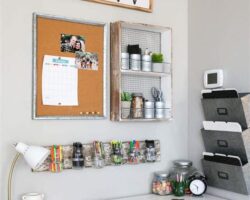As the modern workforce continues to evolve, many people are finding themselves transitioning from the traditional office environment to the comfort of their own home. While the idea of working from home may seem like a dream come true, the reality is that it comes with its own set of challenges. In this blog post, we will explore some essential tips for making a successful transition from a traditional office to a home office. From setting up a designated workspace to maintaining work-life balance, we will cover everything you need to know to make the most out of your new work environment. Whether you are a seasoned remote worker or making the switch for the first time, these tips will help you stay motivated, focused, and productive while working from home. So, grab your favorite cup of coffee and get ready to take your home office to the next level!
Setting up a designated workspace
Setting up a designated workspace is crucial for anyone who is working from home. It is important to create a space that is separate from the rest of your home, where you can focus and be productive. This space should be comfortable, well-lit, and free from distractions. It’s also a good idea to personalize your workspace with items that inspire and motivate you.
When setting up your designated workspace, it’s important to consider ergonomics. Choose a comfortable chair and make sure your desk is at the right height to prevent strain on your back and neck. Investing in a good quality monitor, keyboard, and mouse can also help to prevent injury and make your workday more comfortable.
Another important aspect of setting up a designated workspace is having the right organizational tools. This could include file organizers, drawers, shelves, or anything else that can help you keep your workspace tidy and free from clutter. A tidy workspace can help improve focus and productivity.
Finally, it’s important to establish boundaries around your designated workspace. This means setting clear expectations with other members of your household about when you are working and should not be disturbed. It’s also important to mentally associate your designated workspace with work, so that when you are in that space, you are in work mode.
Establishing a daily routine
Setting up a consistent daily routine is crucial for maintaining productivity and balance while working from home. It can be tempting to sleep in and start work whenever you feel like it, but having a structured routine helps to create a sense of normalcy and purpose.
Start your day at the same time each morning, just as you would if you were going into an office. This helps to signal to your brain that it’s time to start the workday, and can prevent you from feeling lethargic and unmotivated.
Take regular breaks throughout the day to avoid burnout, but also make sure to set specific start and end times for your work hours. This will prevent you from overworking and allow you to mentally switch off after your workday is done.
Most importantly, be flexible and try different routines to see what works best for you. Not everyone is productive at the same time of day, so it’s important to find a routine that suits your natural rhythms and keeps you feeling motivated and focused.
Creating clear boundaries between work and home life
Working from home can blur the lines between our professional and personal lives, making it challenging to maintain a healthy balance. In order to create clear boundaries between work and home life, it is important to establish a designated workspace. This area should be separate from the rest of the house and used exclusively for work. This helps to mentally switch into work mode when entering the space and home mode when leaving it.
Additionally, establishing a daily routine can further reinforce these boundaries. By setting specific work hours and adhering to them, we can better differentiate between when we are on the clock and when we are off. This routine can also include regular breaks and a designated end time to signify the transition from work to personal time.
Choosing the right equipment and technology is also crucial in maintaining these boundaries. Having dedicated work tools and devices that are used exclusively during work hours can help to compartmentalize our professional and personal lives.
Lastly, it is important to communicate with family members or housemates about our work boundaries. By setting clear expectations and boundaries with those we live with, we can minimize distractions and interruptions during work hours, thereby maintaining a healthier work-life balance.
Choosing the right equipment and technology
When working remotely, it is crucial to choose the right equipment and technology to ensure productivity and efficiency. Investing in a reliable laptop or desktop computer with a high-speed internet connection is essential for seamless communication and collaboration with colleagues. Additionally, selecting the appropriate software and tools that align with the nature of your work is equally important in order to streamline tasks and maintain productivity.
Furthermore, choosing the right equipment and technology also involves considering ergonomic office furniture, such as an adjustable chair and ergonomic keyboard, to promote a healthy and comfortable work environment. Prioritizing devices with built-in security features can also help safeguard sensitive data and minimize the risk of cyber threats when working remotely.
It is also essential to assess the specific requirements of your role and industry when choosing the right equipment and technology. For instance, graphic designers may require a high-resolution monitor and advanced design software, while customer service representatives may benefit from a reliable headset for seamless communication with customers.
In conclusion, choosing the right equipment and technology plays a pivotal role in the success of remote work. By carefully evaluating the needs of your role and industry, investing in reliable technology, and prioritizing ergonomic office equipment, you can create an efficient and productive remote work environment.
Staying motivated and focused
Working from home can sometimes present challenges when it comes to staying motivated and focused. Without the structure of a traditional office setting, it can be easy to become distracted and lose sight of your goals. However, there are several strategies that can help you stay on track and maintain your focus.
One important step in staying motivated and focused while working from home is to establish a daily routine. By setting regular work hours and adhering to a consistent schedule, you can create a sense of structure and purpose that can help keep you on task.
Another key factor in maintaining motivation and focus is to manage distractions effectively. This may involve setting boundaries with family members or housemates, creating a dedicated workspace free from clutter and noise, and implementing techniques such as the Pomodoro method to break up tasks and stay on track.
Additionally, it’s important to maintain regular communication with colleagues to stay connected and engaged. This can help you stay motivated by providing a sense of camaraderie and support, and can also help you stay focused by keeping you accountable to others.
Maintaining regular communication with colleagues
Working from home can sometimes feel isolating, especially when you’re used to the constant interaction with colleagues in an office setting. It’s important to establish a routine for regular communication with your co-workers to maintain a sense of connection and teamwork.
Utilizing video conferencing tools such as Zoom or Microsoft Teams can be a great way to regularly check in with your colleagues. Schedule weekly team meetings or one-on-one catch-ups to discuss ongoing projects, share updates, and simply chat about non-work related topics to keep the social aspect alive.
Another way to maintain regular communication is to use instant messaging platforms like Slack or Microsoft Teams to keep in touch throughout the day. This allows for quick questions, updates, and general conversation as if you were in the office, promoting a collaborative environment.
Don’t forget to also utilize email for more formal communication, such as sharing important documents, project updates, or setting up meetings. It’s important to find the right balance between instant messaging and email to ensure effective communication without overwhelming your colleagues.
Managing distractions and maintaining work-life balance
Working remotely can come with its own set of challenges, including managing distractions and maintaining a healthy work-life balance. It can be easy to get sidetracked by household chores, family members, or other personal responsibilities while trying to focus on work. Finding a way to minimize distractions and stay focused is crucial to maintaining productivity and achieving a healthy work-life balance.
One way to manage distractions is to set up a designated workspace in your home. Creating a specific area where you can work without being interrupted by household activities can help you stay focused and minimize distractions. This could be a separate room, a quiet corner, or even a specific desk or table where you can concentrate on your work without being pulled away by other responsibilities.
Establishing a daily routine can also help in managing distractions and maintaining work-life balance. By setting specific work hours and sticking to a consistent schedule, you can create boundaries between your professional and personal life. This can reduce the temptation to work outside of regular hours and help you maintain a healthier balance between work and family time.
Additionally, choosing the right equipment and technology can play a significant role in minimizing distractions and staying focused. Investing in noise-cancelling headphones, a comfortable ergonomic chair, and other tools that can enhance productivity can help create a more conducive work environment. Utilizing productivity apps and software can also help you stay organized and focused on your tasks.





